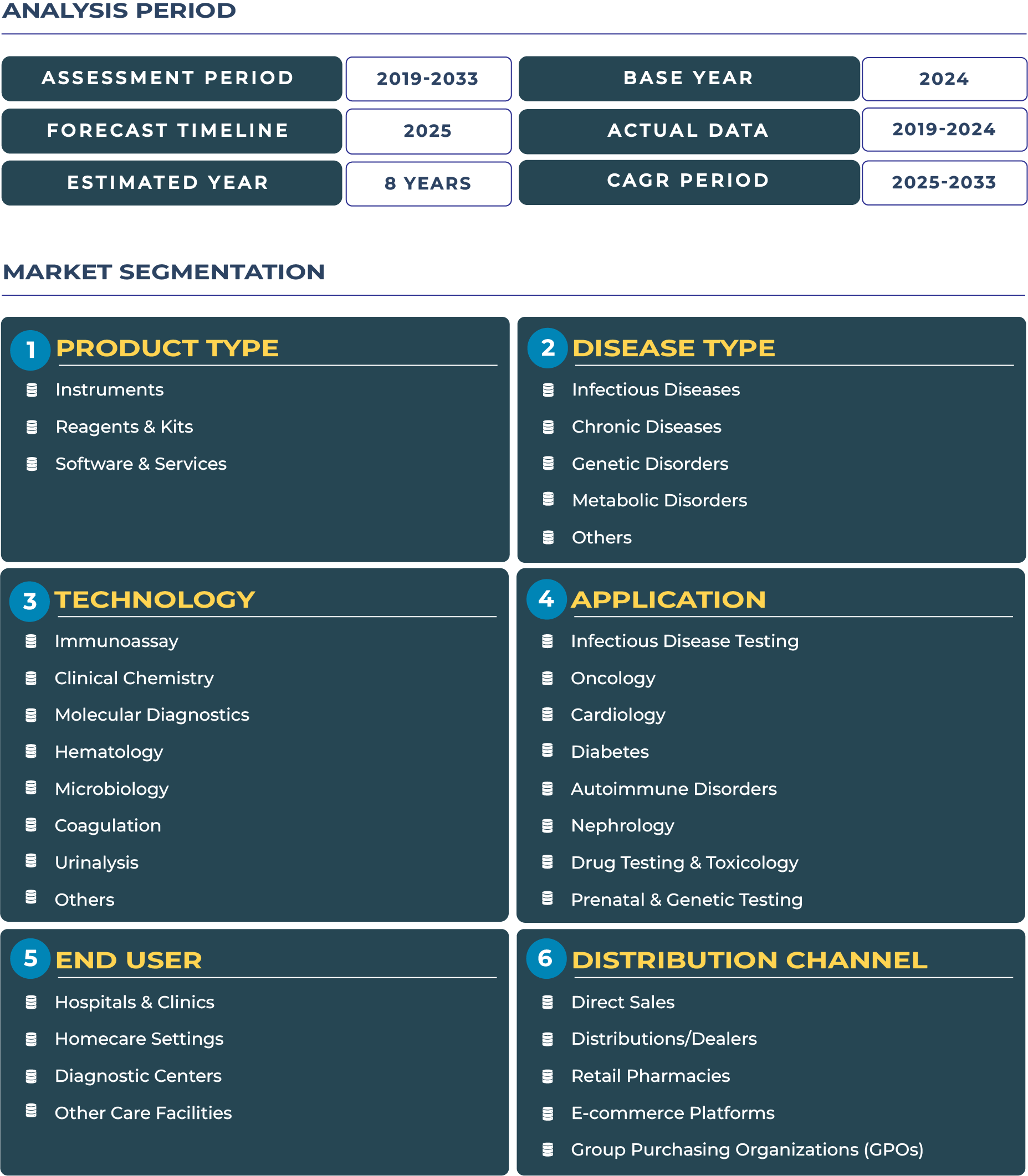Russia In-Vitro Diagnostic Market: National Health Projects Powering Diagnostic Modernization
The Russia In-vitro Diagnostic (IVD) market is undergoing a major transformation, fueled by state-backed health initiatives, digital integration, and growing localization efforts. The country’s ambitious national healthcare programs, notably under the “Health” national project, have accelerated hospital modernization, driving procurement of advanced diagnostic solutions across both public and private sectors. This state-driven investment, coupled with strategic emphasis on early disease detection, has created a fertile environment for domestic and international manufacturers to expand within the diagnostic ecosystem.
In 2025, the Russia IVD market is projected to reach USD 2.07 billion and is anticipated to grow to USD 3.24 billion by 2033, reflecting a steady CAGR of 5.8% from 2025 to 2033. This growth trajectory is supported by the modernization of laboratory networks, increased testing volumes in infectious and chronic diseases, and the rising integration of molecular and immunoassay technologies. The government’s push for domestic innovation and self-reliance, accelerated by sanctions, has further reinforced the sector’s strategic importance within the country’s broader healthcare modernization plan.
Public Investment and Hospital Modernization: The Cornerstone of Market Expansion
Russia’s healthcare infrastructure is being rapidly reshaped by the infusion of public funds through programs such as the Ministry of Health of the Russian Federation‘s regional health initiatives. Large-scale tenders for diagnostic reagents and instruments have boosted the role of local procurement systems, ensuring hospitals in both metropolitan centers like Moscow and emerging urban zones are equipped with modern testing platforms. Furthermore, the surge in chronic disease management, preventive screening, and pandemic preparedness has spurred high demand for reagents and automated testing systems in public laboratories.
These modernization projects are not merely about infrastructure, they symbolize a paradigm shift toward preventive care and data-driven clinical decision-making. By integrating laboratory information systems and enhancing reagent standardization, Russia is aligning its healthcare system with international diagnostic quality frameworks, while ensuring economic sustainability through local manufacturing and service support.
Key Market Drivers and Restraints Shaping Russia IVD Growth Trajectory
Growing Diagnostic Infrastructure and Domestic Production Fuel Market Momentum
The Russia in-vitro diagnostic industry is witnessing a structural transformation driven by its large network of urban hospitals, expanding trauma and emergency care units, and increasing demand for rapid diagnostics in oncology and infectious diseases. The rise of domestic manufacturing capacity, supported by localization mandates under government policy, has significantly enhanced supply stability and reduced dependency on imports. Moreover, Russia’s high trauma incidence and aging population are translating into continuous testing demand for preoperative and post-treatment assessments.
Private hospital chains are increasingly adopting point-of-care testing (POCT) and software-integrated diagnostic systems, optimizing workflow efficiency and turnaround time. Simultaneously, local reagent and kit manufacturers have started supplying to provincial hospitals, improving accessibility and reducing overall cost-per-test.
Import Restrictions, Currency Volatility, and Policy Uncertainty Hamper Expansion
Despite its growth trajectory, the Russia IVD market faces several structural challenges. Sanctions and geopolitical restrictions have complicated import procedures for diagnostic reagents and precision instruments, especially from Western markets. This has slowed technology transfers and access to certain high-end molecular platforms. Additionally, currency volatility and inconsistent procurement cycles in public hospitals have created budget allocation difficulties, impacting timely equipment replacement and reagent supply chains.
Regulatory complexity also poses obstacles, as manufacturers face extended registration timelines for imported kits and reagents under the updated medical device framework managed by Roszdravnadzor. These factors collectively create market friction, though they simultaneously encourage innovation and capacity-building among domestic diagnostic firms.
Emerging Trends and Strategic Opportunities Defining the Russian IVD Landscape
Domestic Suppliers Gain Momentum Amid Healthcare Regionalization
Amid ongoing geopolitical shifts, the Russia in-vitro diagnostic sector has witnessed a pronounced shift toward domestic production and supplier regionalization. Regional hospitals, particularly in St. Petersburg, Nizhny Novgorod, and Yekaterinburg, are increasingly adopting equipment from Russian manufacturers that offer competitive reagent pricing and robust maintenance support. Government subsidies for clinical laboratories developing indigenous diagnostic assays have also strengthened local innovation pipelines, particularly in molecular diagnostics and hematology analyzers.
Localization and After-Sales Services Present Significant Growth Windows
Opportunities are emerging in localization of manufacturing, tele-laboratory support, and remote diagnostics, especially in Siberia and the Far East. International firms partnering through joint ventures are gaining resilience against import challenges while ensuring continuity of high-end testing solutions. The growing emphasis on after-sales services, training, and spare part availability further strengthens operational reliability for regional labs. Additionally, advancements in diagnostic software and data analytics are enabling real-time results tracking and integration with national electronic health records, reinforcing Russia’s goal of healthcare digitalization.
Competitive Landscape: Localization, Partnerships, and Strategic Positioning
The Russian IVD market is characterized by a mix of international players such as Roche and Siemens Healthineers, alongside emerging local firms including Vector-Best and Diagnostic Systems. Strategic partnerships have become essential to maintaining market presence. Companies are increasingly forming local manufacturing joint ventures (JVs) and establishing reagent warehouses to stabilize logistics under import restrictions. Roche’s collaboration with local distributors to expand molecular testing for oncology in 2024 exemplifies the adaptive strategies driving market competitiveness.
Training programs for provincial laboratory staff, sponsored by multinational and domestic firms alike, are improving technical proficiency and ensuring proper equipment utilization. These initiatives not only build trust in diagnostic reliability but also align with Russia’s healthcare digitalization objectives.







